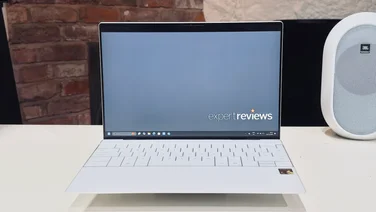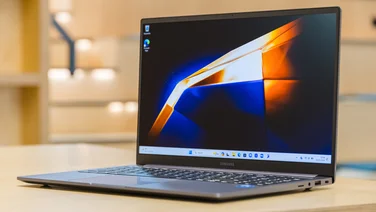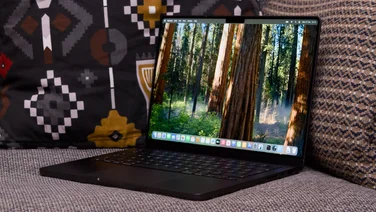To help us provide you with free impartial advice, we may earn a commission if you buy through links on our site. Learn more











- Gorgeous looks
- Great battery life
- Superb performance
- No £999 base model
- 256GB SSD is (reportedly) slow
The redesigned M2 MacBook Air has had hundreds of thousands of words dedicated to it in recent weeks across a multitude of reviews and news stories. That’s not particularly noteworthy: the follow-up to what has been the best laptop in recent memory – the M1 MacBook Air (£949) – was bound to attract more than its fair share.
What has perhaps been surprising is that not all the coverage has been positive. Concerns over performance have been expressed about Apple’s latest lightweight laptop, particularly at the base model’s SSD, as well as the significant rise in price.
Maybe that’s to be expected. After its predecessor was received with such universal acclaim when it first launched, it was perhaps inevitable the M2 wouldn’t be welcomed with such enthusiasm.
READ NEXT: These are the best laptops you can buy today
M2 Apple MacBook Air (2022) review: What you need to know
Does this mean the M2 MacBook Air is a bad laptop? Absolutely not. It may not make as big a statement as the original M1 MacBook Air in its day, but it is a better laptop (with one caveat) across the board. And that means it’s still the best laptop in its category – by a distance.
The most obvious change this year is to the overall design. Gone is the famous wedge profile the MacBook Air has had since birth in favour of a uniformly flat shape that’s the same thickness from front to back and a little more rounded in the corners.











It’s still achingly pretty, especially in the new Starlight colourway, and Apple has also shaved off a small amount of weight, with the new machine tipping the scales at 1.24kg versus 1.29kg for the older laptop. The M2 MacBook Air is far from the lightest in its category – Samsung’s Galaxy Book2 Pro 13.3in is an airy 870g – but, subjectively, it feels like Apple has shaved off more than a mere 50g. Perhaps that’s due to the change in shape and the inevitable change in weight distribution, but it certainly feels much lighter.
Other changes are equally subtle. The screen is now 13.6in (vs 13.3in) and has a taller 16:10 aspect ratio, and there’s now a notch in the top centre housing the webcam. That webcam has had a resolution boost to 1080p and delivers much improved video-calling visuals.











There’s also an improved quad-speaker audio system, and MagSafe charging has returned after an absence of three years (yes, I thought it had been longer as well). There are two new colours to choose from – Midnight and Starlight – to add to Space Grey and Silver. Fans of Rose Gold, I’m afraid, are going to be disappointed as that’s no longer an option for the M2 MacBook Air.
Of course the most significant change is the move to Apple’s second-generation laptop SoC: the Apple M2. This chip is available in two flavours – one with an integrated eight-core GPU and one with ten-core graphics – and Apple is claiming plenty of performance upgrades with an 18% uptick in CPU performance, a boost of 35% for graphics and 40% for its Neural Engine.
READ NEXT: The best laptops for students
M2 Apple MacBook Air (2022) review: Price and competition
Configuration tested: Apple M2 with 10-core GPU, 8GB RAM, 512GB SSD. Price: £1,549
All of these small improvements add up to a laptop that is significantly better than its predecessor. The one big disappointment is that the price has been hiked, with the cheapest model now costing £250 more than the M1 did at launch. It’s worth noting that the base M2 MacBook Air comes with an eight-core GPU where the cheapest M1 had a cut-back seven-core GPU. However, it’s still disappointing that there’s no £999 option at all.
So what else does your £1,249 get you? A fairly meagre 8GB of RAM and only 256GB of SSD storage. If you want more RAM it will cost you another £200 to up it to 16GB and a further £200 to go to 24GB. Upgrading to a 512GB SSD costs another £200, 1TB an extra £400 and the 2TB model adds £800. Finally, if you want the 10-core GPU, that’ll be another £100. That means the priciest MacBook Air will set you back an astonishing £2,549.
Still, that’s not the specification most folk will opt for, so let’s focus on the cheaper models and what the Windows opposition has to offer at those sorts of prices.











Suffice to say, there’s plenty around that’s decent and it’s fairly easy to find a cheaper machine that comes with more RAM and storage than the M2 MacBook Air. You can, for instance, nab the aforementioned super lightweight Samsung Galaxy Book2 Pro for £999 – that comes with a 12th gen Intel Core i5-1240P, 8GB of RAM and a 256GB SSD.
Acer’s 2022 Swift 3 isn’t as light as the Samsung and makes do with an 11th gen Intel CPU and a 1080p display but it’s just as portable as the M2 MacBook Air and comes with 8GB of RAM and a 512GB SSD for a mere £700 – even less if you wait for the sales.
Then there’s the Huawei MateBook 14s, which is a bit chunkier and heavier than the MacBook Air at 1.4kg but absolutely trounces it for value. At the time of writing you can get one for £910, and it comes with a crisp 14in 2.5K 90Hz display, a Core i7-11370H CPU, 16GB of RAM and a huge 1TB SSD. On paper, it would seem, Apple’s rivals have plenty to offer.
READ NEXT: The best MacBooks to buy
M2 Apple MacBook Air (2022) review: Design and features
None, however, can quite match the MacBook Air’s overall appeal. The gorgeous new design refreshes what was becoming a rather stale look while retaining the build quality MacBooks are famous for. In fact, I think I prefer the way it looks and feels now and the reintroduction of MagSafe means you’re far less likely to drag it onto the floor by accident and ruin that pristine appearance.
It’s full of other lovely design touches, too. The lid, for instance, is perfectly weighted so you can open it with one finger without tipping the laptop over. The “Magic” keyboard has just the right amount of travel and feedback – it’s truly a joy to type on – and the Force Touch trackpad works as wonderfully well as it always has. There’s still no better touchpad on a laptop than this. Windows laptop manufacturers take note.











The new quad-speaker audio system is impressive, pumping out rich audio at a decent volume level with a surprisingly spacious soundstage, and the new 1080p FaceTime HD webcam captures much cleaner, crisper visuals; this is an improvement that has been a long time coming. The new three-microphone arrangement is excellent, although it would be nice if it captured less background noise.
The MacBook Air isn’t quite the perfect laptop, however. I would, for instance, prefer it if the two Thunderbolt 3 ports were spaced out a little more than they are on the left edge. Although most cables should co-exist, they’re close enough that some accessories might not squeeze in next to each other.











It’s the M2 MacBook Air’s webcam, however – housed in a rather ugly inch-wide notch at the top of the 13.6in display – that’s the most problematic part of the design. I simply can’t see why it’s needed, especially since there are no extra Face ID sensors or electronics and no physical privacy shutter to occupy the space. I suspect the next generation of MacBooks will do away with the notch and Apple will claim it’s some kind of upgrade.
M2 MacBook Air (2022) review: Display
Still, if you can learn to live with the notch, the new “Liquid Retina” display is a useful upgrade. It’s larger than the standard “Retina” display on the old M1 MacBook Air by 0.3in, brighter by a claimed 100cd/m² and the aspect ratio is a slightly more practical 3:2 versus the 16:10 of its predecessor.
It also retains those quality-of-life features that elevate a modern MacBook over many of its Windows contemporaries: TrueTone, which matches the white point of the display to the lighting in the room you’re working in, and wide P3 colour coverage, although more and more Windows machines have been following suit in this area recently. The one place in which the M2 MacBook Air is lacking is the refresh rate, which remains stuck at a lowly 60Hz. I’d have hoped to see Apple making the move to at least 90Hz, if not 120Hz by now.
Still, it’s a top quality display. In my testing, brightness peaked at 549cd/m², a good 49cd/m² higher than the quoted 500cd/m², with a contrast ratio of 1,416:1 and colour reproduction covering 96.1% of the P3 colour space. Colour accuracy is impressive, too, with an average Delta E colour variance score of 1.13 versus DisplayP3.
What all this boils down to is that it’s a very good screen. Not, perhaps, up to the standards of the OLED screen on the Samsung Galaxy Book2 Pro when it comes to sheer colour vibrance, contrast ratio and black level, but it’s certainly sharper and just as practical in day-to-day use.
READ NEXT: Our roundup of the best Apple iPads
M2 MacBook Air (2022) review: Performance
Now that Apple Silicon is nearly into its third year of existence, most issues with a lack of native compatibility have all but vanished and we can now appraise performance largely without caveats.
On paper, the second generation of Apple silicon is impressive. The new M2 chip is a significant step forwards and, like the M1 chip, it’s an octa-core part with four cores dedicated to high performance tasks and four that take over when the demands are less strenuous. And, just like the M1, it’s built using a 5nm manufacturing process.



It runs at a higher 3.49GHz clock speed than the M1’s 3.2GHz, however, has more memory bandwidth (100GB/sec versus 68.5GB/sec) and support for up to 24GB of RAM where the M1 was limited to a maximum 16GB. Not only that, but the M2’s neural engine is a claimed 40% faster and, perhaps more significantly, the chip’s media engine has been upgraded to accelerate not only H.264 and HEVC video encoding and decoding but also ProRes and ProRes RAW video.In our standard set of benchmarks it’s clear that the M2 is a significant step up from the M1. We’re not talking a huge jump but it’s a big enough increase across generic CPU and GPU tasks to warrant upgrading, even before you get to the boost available to anyone editing high-resolution ProRes video.


Indeed, if your workload involves doing anything with ProRes video, the new hardware acceleration is worth the price of admission alone. Here’s a quick idea of how effortlessly the M2 handles playing back a 4K 4:4:4:4 ProRes video clip versus the M1 in a Mac mini; it barely breaks a sweat, while the M1 has its work cut out just playing the clip without dropping frames. If you start pushing this using DaVinci Resolve to layer up ProRes video the M1 quickly starts to struggle while the M2 sails effortlessly through the task. Better still, the M2 MacBook Air manages to pack all this power in without a hit to efficiency. In fact, in our video rundown test (with the display set to 170cd/m² and wireless disabled) I found it lasted longer than the M1 in the same test – exactly 17 hours – and this puts most Windows laptops to the sword.The only caveat I’d throw out there when it comes to performance is SSD storage. Although the 512GB SSD in my review sample performed at around the same level as the M1 MacBook Air’s SSD, it has been widely reported that the 256GB SSD in the base M2 MacBook Air suffers from significantly slower performance – by around 15% to 30% – because of the way the SSD chips are configured.

That’s disappointing and means anyone who wants to make the most of the M2’s improvements in general speed and accelerated video editing/playback capabilities will have to stump up not £1,249 for the base model but a minimum of £1,449 for the model that comes with 512GB of storage.
M2 Apple MacBook Air (2022) review: Verdict
That leaves a slightly sour taste in the mouth, but does it do enough to undermine the M2 MacBook Air’s overall appeal? If Apple hadn’t raised the price of the base model by £250 I’d be minded to dismiss it with a wave of the hand. Alas, the price hike means anyone who can only afford the cheapest model will be paying more for what is, in one aspect, a slower laptop than the older and cheaper M1.
That’s a shame because, in general, the M2 MacBook Air is a triumph. It’s slim, light and attractive. Its battery will last you all day and then some. Its fanless design means it runs completely silently. And it’s a more capable laptop from a performance perspective than any rival Windows ultraportable.
In short, there is no laptop that I’d rather take away on a work trip. There is no laptop – if I had to have one computer – that I’d rather have as my daily driver. However, it’s not quite the outright bargain its predecessor was.
| Apple MacBook Air (M2, 2022) specifications | |
|---|---|
| Processor | Apple M2 |
| RAM | 8GB |
| Additional memory slots | No |
| Max. memory | 24GB |
| Graphics adapter | Apple M2 (8-core or 10-core) |
| Graphics memory | Shared |
| Storage | 512GB |
| Screen size (in) | 13.6 |
| Screen resolution | 2560 x 1664 |
| Pixel density (PPI) | 225 |
| Screen type | IPS |
| Touchscreen | No |
| Pointing devices | Touchpad |
| Optical drive | No |
| Memory card slot | No |
| 3.5mm audio jack | Yes |
| Graphics outputs | Thunderbolt 3 |
| Other ports | Thunderbolt 3/USB-C 4.0 x 2 |
| Web Cam | 1080p |
| Speakers | Quad |
| Wi-Fi | Wi-Fi 6 |
| Bluetooth | Bluetooth 5.0 |
| NFC | No |
| Dimensions, mm (WDH) | 304.1 x 215 x 11.3mm |
| Weight (kg) – with keyboard where applicable | 1.24kg |
| Battery size (Wh) | 52.6Wh |
| Operating system | MacOS Monterey |






